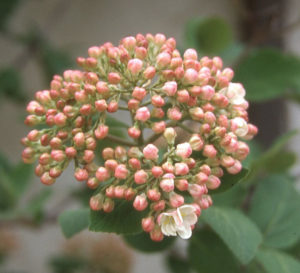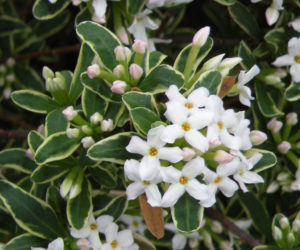 Unconsciously, I always hope that entering a garden will be a joy for all my senses. Frequently, however, the only sense experienced is that of sight. Whatever happened to also designing for smell, taste, sound, and touch?
Unconsciously, I always hope that entering a garden will be a joy for all my senses. Frequently, however, the only sense experienced is that of sight. Whatever happened to also designing for smell, taste, sound, and touch?
Smell
If we have been enticed by fragrance, we inevitably try to find its source and then some of us also try to define it.

Syringa vulgaris-namethatplant-wordpress-com – The common lilac is extremely fragrant but needs to be pruned each year once as it approaches maturity.
The scent with which most people are familiar is that of Lilac (Syringa vulgaris). For many of us, it’s a scent that reminds us of childhood, having been in the gardens of our parents or grandparents. Old lilacs are frequently tall and dense, left unpruned for years, and thus all of the blooms are ten to fifteen feet high. Properly pruning lilacs is a lot of work – cutting out one third of the old trunks each year and thinning out the suckers – but it does result in large trusses that are closer to our noses.

Syringa meyeri – This fragrant dwarf lilac blooms in June while the Russian sage in front of it will not bloom until August.
I used to have a Syringa meyeri, a dwarf that, supposedly, would only grow five feet tall and wide. However, it forgot to read the catalog and I found myself pruning it annually to keep it at five feet. Eventually I decided that it was too time consuming to keep it at the desired size. I do wish it had stayed small because I miss the fragrance.

Imagine following your nose and finding the pink buds of Viburnum carlesii that open to softball-sized globes of white florets.
I also used to have a Viburnum carlesii ‘Compactum’ with its pink buds and its globes of white florets that emitted a heavenly scent. Unfortunately, it was either mislabeled or forgot to read the catalog. Located in a space only five feet wide and deep, it insisted on trying to grow much larger and would rub against the house walls. Alas, it, too, has been ejected from the garden. If you have space, I urge you to plant one.

Although the scent of Daphne ‘Carol Mackie’ is fleeting, the variegated foliage lends interest to the landscape for several months.
For a long time, I was blessed with a Daphne ‘Carol Mackie’. Happily sited in full sun and irrigated on a regular basis, she grew much larger than I ever dreamed she could. Her beautifully variegated foliage pleased me every day even though the dainty fragrance only lasted for a few weeks in the spring. Sad to say, five years ago, the heavy snows of winter broke her branches so badly that she never recovered.
What are your favorite woody plants that please you with their fragrance?


0 Comments